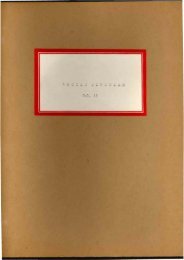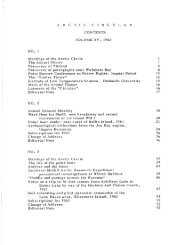Volume 4, 1951 - The Arctic Circle - Home
Volume 4, 1951 - The Arctic Circle - Home
Volume 4, 1951 - The Arctic Circle - Home
You also want an ePaper? Increase the reach of your titles
YUMPU automatically turns print PDFs into web optimized ePapers that Google loves.
will it be possible to determine what number of animaIs may<br />
be killed annually by hunters, without endangering the main<br />
stock.<br />
Barren ground caribou were once plentiful in Ungava<br />
and Labrador but during the last fifty years they have aUlost<br />
completely vanished and only in recent years have there been<br />
reports of slight increases in the Fort Chimo area (Wright,<br />
1944; ~anning, 1948); in Baffin Island caribou have been<br />
decreasing during the last few decades at such an alarming<br />
rate that total protection has lately been considered<br />
necessary. Labrador-Ungava and Baffin Island physiographically<br />
are very different from the vast continental area west of<br />
Hudson Bay but in many respects are comparable with the icefree<br />
parts of Greenland.<br />
Several causes have been advanced to explain the rapid<br />
disappearance of the barren land caribou in Labrador-Ungava<br />
but thus far no very satisfactory explanation has been given.<br />
ln Baffin Island, however, it is thought that excessive<br />
hunting is the primary cause of depletion (Wright, 1944).<br />
Practically no statistical information is available for either<br />
area and it is not possible, therefore, even to estimate past<br />
or present populations of the numbers killed by hunting. ln<br />
Greenland, on the other hand, caribou have been rather closely<br />
observed for more than two hundred years by Danish scientists<br />
and administrators, and it may be of interest to note briefly<br />
what has happened there. ln comparing the two areas it should<br />
be noted that in Greenland the caribou is more vulnerable to<br />
hunting because the ice-free parts of Greenland are deeply<br />
indented by fjords which in many parts extend to the very<br />
edge of the great inland ice which covers all the interior<br />
of that island. <strong>The</strong>se fjords not only make the areas inhabited<br />
by caribou accessible to Eskimo hunters summer and<br />
winter, but they also impede north and south migration of the<br />
caribou. Furthermore, there are places along the Greenland<br />
coasts where huge glaciers, in sorne cases more than 50 miles<br />
in width, form impassable barriers to coast-wise migration.<br />
<strong>The</strong> Greenland caribou, on the other hand, does not<br />
suffer from the predation of warble or nostril flies because<br />
those pests apparently never reached Greenland. On the west<br />
coast, too, there are no wolves. Another factor which undoubtedly<br />
has been of inestimable conservational value is<br />
that even to this day ail hunting in Greenland is done with<br />
single-shot rifles. No loaded shells are sold to Greenlanders<br />
who can buy only black powder for reloading. While the use<br />
of single-shot, black powder rifles and shotguns may at first<br />
appearance seem anachronistic, the practice nevertheless is












